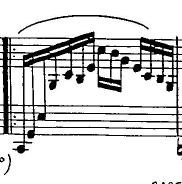

The current issue of The American Harp Journal includes a wonderful article by Melina van Leeuwen entitled SALZEDO’S NEW HARPISM. Of particular interest is his elimination of rests as a compositional principle for harp.
This is really an important idea for harpists. Rests, unless we intentionally dampen a string, do not accomplish silence on harp and so, to add them is superfluous and makes interpreting the music more difficult. Especially for those most familiar with music written by harpists, we simply don’t see them scattered though our music in the way they are for keyboard or other instruments.
According to van Leeuwen, there are six idiomatic principles of which to be aware, the first of which is the “omission of rests unless needed for rhythmic clarity”. As the resonance is the main character of harp that separates it aurally from piano, it is also the reason rests in music hold less significance to the performer.
It’s been my frustration, when doing work for hire, that in editing by the publisher, they sometimes “take the harp out” and “insert too much piano” and as I read this article, it occurred to me that most of the disagreement comes on this issue, the harpistic approach vs. the pianistic approach. Each is helpful for its own idiom.
Bernard Andrés has expanded on beautiful notation for harp and a study, especially of his manuscript shows his careful choices in notation. Not only his lack of unnecessary rests, but his use of beaming in CHANTS D’ARRIERE-SAISON (harp and cello or bassoon, or horn) makes the difference between the piece being very close to sight readable (though difficult) and the need for assessment of the structure. I use this piece as an example only because the music was issued in both manuscript (shown on the right) and an engraved edition (shown on the left).
In a rare turn of events, the manuscript of this score is easier by far to read than the engraved edition, which also, sadly, contains a large number of errata. I’ve not had contact with a harpist performing the piece since 2016 when Colleen Potter Thornburn and Delaine Leonard helped sort out the new edition against the manuscript and recordings. See two examples below and more in the article in the Harp Journal. If you need a list of errata, let me know. If you know that corrections have been made, I'd appreciate that info as well.
Movement 6: The beaming of the notes in the manuscript (image on the right) simplifies reading both placement and rhythmic structure. Notice that there are rests in the engraved edition (left) but not in the manuscript (right). Also, note the notes in the bass clef and compare between the two notational choices: the simplified notation on the right wouldn't work for piano, as they wouldn't know to hold that first octave longer, but it's going to do that on harp unless it's damped, so the example on the right is suits harp well.


Movement 7: The cross staff beaming in the manuscript (image on the right), makes it very quick to see the most efficient way to finger this, without brackets or fingerings. At a glance, I can see where I need to reach and how things fit. Notice that there are rests in the engraved edition (left) but not in the manuscript (right).

